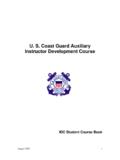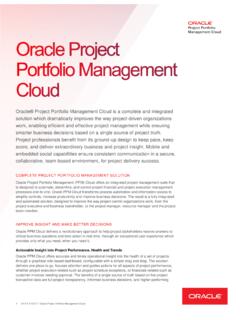Transcription of Performance Improvement Guide - CGAUX
1 D rE GuaPERFORMANC t Improvement s CoaGUIDE . Sixth Edition November 2014 Editors: Mr. Charlie Coiro Christen M. Wehrenberg CWO3 Craig Kerby BMC William Donahue LT Anna Hart-Wilkins MSTC Anthony Matulonis CWO2 Jaime Baldueza Contributors: CDR Robert Albright Nancy Almeida CWO Jaime Baldueza CWO Michael J. Brzezicki SCPO Robert R. Buxman CPO John M. Callaghan Kristy Camacho Charles D. Coiro Pam Dittrick LT Alanna Dunn CDR Frank Irr CWO Craig Kerby LT Jacqueline M. Leverich Lori J. Maselli MSTC Anthony Matulonis Paul E. Redmond Jason M. Siniscalchi, LCDR Richter L. Tipton Christen M. Wehrenberg Stephen B. Wehrenberg, Frank S. Wood Jeff L. Wright If this Guide is used as a reference in preparing a research paper or other publication, we suggest acknowledgement citation in the references.
2 A suggested bibliography entry in APA or author (date) style is as follows: Coast Guard Leadership Development Center (2014). Performance Improvement Guide , 6th edition. Boston, MA: Government Printing Office. 2 Preface to Sixth Edition The Performance Improvement Guide (PIG) is published by the Coast Guard Leadership Development Center. The Coast Guard strives to be the best-led and best-managed organization in government. That s a never-ending challenge for all Coast Guard people. This Guide is designed to help you respond to this challenge; its contents were selected to involve employees, enhance team effectiveness, focus problem-solving, facilitate better meeting management, improve processes, increase customer satisfaction, and improve overall Performance to produce superior mission results.
3 The PIG is an ideal source of tools, processes, and models. Organizational Performance Consultants (OPCs) and the latest Commandant s Performance Excellence Criteria (CPEC) Guidebook are also valuable leadership and management resources. The Leadership Development Center (LDC) appreciates the Improvement suggestions made by users of previous editions. Though the PIG format remains largely the same, its contents and organization have changed. Changes to this edition include: A reorganized and expanded Tools section Updates to examples Updates to wording choice and explanations to reflect the Coast Guard s evolution in its continuous Improvement efforts We hope you find this a useful, informative resource. The Leadership Development Center Staff 3 CONTENTS SIXTH EDITION.
4 1 COAST GUARD LEADERSHIP COMPETENCIES .. 7 LEADERSHIP RESPONSIBILITIES .. 9 SENIOR 10 Effective 11 Strategic 13 DOES EVERY UNIT NEED ITS OWN STRATEGIC PLAN? .. 14 WHY DOES A UNIT NEED ITS OWN VISION?.. 19 COAST GUARD CORE VALUES .. 20 SWOT ANALYSIS .. 24 GOAL WRITING 25 THE BALANCED STRATEGIC PLAN .. 28 TEAM LEADERSHIP .. 31 Organizational Interface .. 33 Team Building .. 35 Project Management .. 36 FACILITATIVE 39 Facilitator 41 Facilitator 44 Facilitator 45 The Facilitative Leader .. 46 MEETING MANAGEMENT .. 47 Effective 47 Planning a Meeting .. 49 Agenda 49 Team Member 50 Ground 51 Parking Lot .. 52 Meeting 54 Facilitating Using Technology .. 57 GROUP LEADERSHIP .. 61 4 Stages of Group 62 Managing 63 ORGANIZATIONAL 64 Systems Thinking.
5 65 The Voice of the 72 Work as a 74 Performance Elements .. 75 Performance 77 Data Collection, Analysis, and 79 activity - based costing (ABC).. 91 The Unified Performance Logic Model (UPLM).. 92 What to Work 94 Process Improvement and Problem-Solving .. 95 CG Organizational Assessment Survey (CG-OAS) .. 99 Coast Guard Business Intelligence (CGBI).. 101 The Commandant s Innovation 103 106 Action Planning .. 107 Affinity Diagram .. 109 Brainstorming .. 113 Cause-and-Effect Diagram .. 116 Charter .. 118 Check Sheet .. 121 Consensus 123 Contingency 125 Control 127 Critical-to-Quality Tree (CTQ).. 129 Customer Alignment 131 Customer Requirements 132 Decision Matrix .. 133 Flowchart .. 135 Force Field 138 Gantt 139 Gap 140 Histogram .. 141 Kano Model .. 144 5 145 Nominal Group Technique.
6 147 Pareto Chart .. 149 Project Requirements 151 Project Responsibility 152 Run 153 Scatter Diagram .. 158 SIPOC .. 159 Stakeholder Analysis .. 161 SWOT 162 Why 164 Work Breakdown Structure (WBS).. 165 GLOSSARY .. 167 REFERENCES .. 170 ADDITIONAL RESOURCES .. 171 TABLE OF TOOL USAGE .. 173 QUICK TOOLS REFERENCE Guide .. 175 6 COAST GUARD LEADERSHIP COMPETENCIES The Coast Guard s definition of Leadership is: You influencing (or inspiring) others to achieve a goal. This Guide provides ideas and resources to help achieve unit and team Improvement goals. The Coast Guard uses 28 Leadership Competencies consistent with its missions, workforce, and core values of Honor, Respect, and Devotion to Duty. These competencies fall into four categories: LEADING SELF o Accountability and Responsibility o Followership o Self Awareness and Learning o Aligning Values o Health and Well-Being o Personal Conduct o Technical Proficiency LEADING OTHERS o Effective Communications o Influencing Others o Respect for Others and Diversity Management o Team Building o Taking Care of People o Mentoring 7 LEADING Performance AND CHANGE o Customer Focus o Management and Process Improvement o Decision Making and Problem Solving o Conflict Management o Creativity and Innovation o Vision Development and Implementation LEADING THE COAST GUARD o Stewardship o Technology Management o Financial Management o Human Resource Management o Partnering o External Awareness o Entrepreneurship o Political Savvy o Strategic Thinking The discussions, strategies, models.
7 And tools in this Guide strongly support the development of most of these competencies. For more information on the Coast Guard s Leadership Competencies, see 8 LEADERSHIP RESPONSIBILITIES Senior leaders, team leaders, and facilitators play key and support roles in managing and improving organizational Performance . These roles include identifying important opportunities, aligning with stakeholders, selecting the appropriate tools, planning work, training team members, cultivating teamwork, implementing solutions, and leading long-term change. The following matrix outlines some key and support roles: Team Role Matrix Role SL TL FAC Team Manages organization Conducts planning Interfaces with organization Selects team Builds team Manages project Coordinates pre- and post-meeting logistics Focuses energy of group on common task Encourages participation Contributes ideas Protects individuals and their ideas from attack Focuses on process Remains neutral Helps find win-win solutions SL = Senior Leaders Key Role TL = Team Leader Support Role FAC = Facilitator The roles, responsibilities, and checklists for senior leaders, team leaders, and facilitators presented in this Guide provide a brief overview.
8 9 SENIOR LEADERSHIP Senior leaders are responsible for effective leadership and management. Excellent organizations: Use management systems, tools and models to gain insight into, and make judgments about, the effectiveness and efficiency of their programs, processes, and people Determine and use indicators to measure progress toward meeting strategic goals and objectives, gather and analyze Performance data, and use the results to drive improvements and successfully translate strategy into action 10 Effective Management The Commandant s Performance Excellence Criteria (CPEC) provides a systematic way to improve management practices across the organization. The criteria are based on the Malcolm Baldrige National Performance Excellence Criteria, which are based on core principles and practices of the highest performing organizations in the world.
9 Category 2 Strategic Planning Organizational Profile: Environment, Relationships, and Strategic Situation Category 6 Operations Focus Category 7 Results Category 5 Workforce Focus Category 1 Leadership Category 3 Customer Focus Category 4 Measurement, Analysis,and Knowledge Management Figure 1. CPEC Framework: A System s Perspective 11 Actively using the criteria fosters Systems Thinking with a focus on factors such as missions, customers, innovation, people, measurement, leadership, processes, readiness, and stewardship. The way each leader manages assigned responsibilities has implications for the entire Coast Guard. In other words, management matters excellent management practices equate to Performance results. The best way leaders can learn how the CPEC can help them accomplish command goals is to use the system.
10 The criteria are built upon eleven core principles and concepts. These principles and concepts are the foundation for integrating key Performance requirements within a results-oriented framework. These core principles and concepts are: Visionary Leadership Customer- driven Excellence Organizational and Personal Learning Valuing Workforce Members and Partners Agility Focus on the Future Managing for Innovation Management by Fact Societal Responsibility Focus on Results and Creating Value Systems Perspective For more CPEC information, see the Commandant s Performance Excellence Criteria Guidebook, COMDTPUB (series) 12 Strategic (Organizational) (Area/District) Strategic Planning Strategic planning is the process by which leaders clarify their organization s mission, develop a vision, articulate the values, and establish long-, medium-, and short-term goals and strategies.









